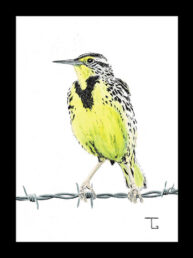Gerry Tietje
My wife Claire and I put together five different state bird puzzles in recent years, which piqued my interest in state birds. The assigning of state birds began in the 1920s after a campaign by the General Foundation of Women’s Clubs. Kentucky was the first to name a state bird and chose the Northern Cardinal; six other states followed suit, choosing the cardinal for their state bird. The Western Meadowlark was chosen by six states, making it the second most popular. We have both of these birds at SaddleBrooke Ranch, along with Arizona’s state bird, the Cactus Wren.
Only 17 states have unique state birds, and Arizona is one of them. The Cactus Wren was made our state bird on March 16, 1931, by the Arizona State Legislature, presumably because it is both common and conspicuous. The Cactus Wren is the largest wren in the United States. Its scientific name is a tongue-twister, Campylorhynchus brunneicapillus, loosely translated as “curved beak” and “brown-capped.” It has a distinctive white eyebrow, cinnamon-buff-colored underparts, and black and white spots. Its common name is very fitting since Cactus Wrens often perch and nest in cholla cacti. Cactus Wrens have several broods a year, so they are often seen gathering nesting material to make their “cozy” nests among the spine-covered branches of the chollas. Males do most of the nest building, females incubate the eggs, and both sexes feed the chicks. They forage for food on the ground, preferring insects and some plant material.
I always get the most likes on Northern Cardinal photos when posted on Facebook. The bright crimson feathers of the male reminded some people of the crimson robes and caps of Roman Catholic cardinals, and this is thought to have inspired the scientific name of this bird, Cardinalis cardinalis. Both sexes have a distinctive topknot and bright orange beak, although females lack the bright red feathers the males display, and are mostly grayish brown. Northern Cardinals feed on insects, seeds, and fruit, the latter containing carotenoids that affect their distinctive feather color.
The Western Meadowlark’s melodious song has been described as a flute-like jumble of gurgling notes; once heard, it is hard to forget. Although “lark” is in its name, meadowlarks are not related to the lark family, but rather, to the blackbird family. Adult Western Meadowlarks (Sturnella neglecta) have a bright yellow breast with a striking black “V” under the neck, a yellow and white eyebrow, black bands on top of the head, and white outer tail feathers that can readily be seen in flight. They are often found in groups foraging together in grasses for bugs and seeds. Cup-shaped nests are built on the ground with plant-covered roofs and entrance runways. Nestlings are fed almost exclusively insects.
If you haven’t seen these colorful state birds around the Ranch, sign up for one of Jim Hoagland’s monthly bird walks on the Nature Trail. Or, set up a table and put together a 1,000-piece state bird puzzle.



